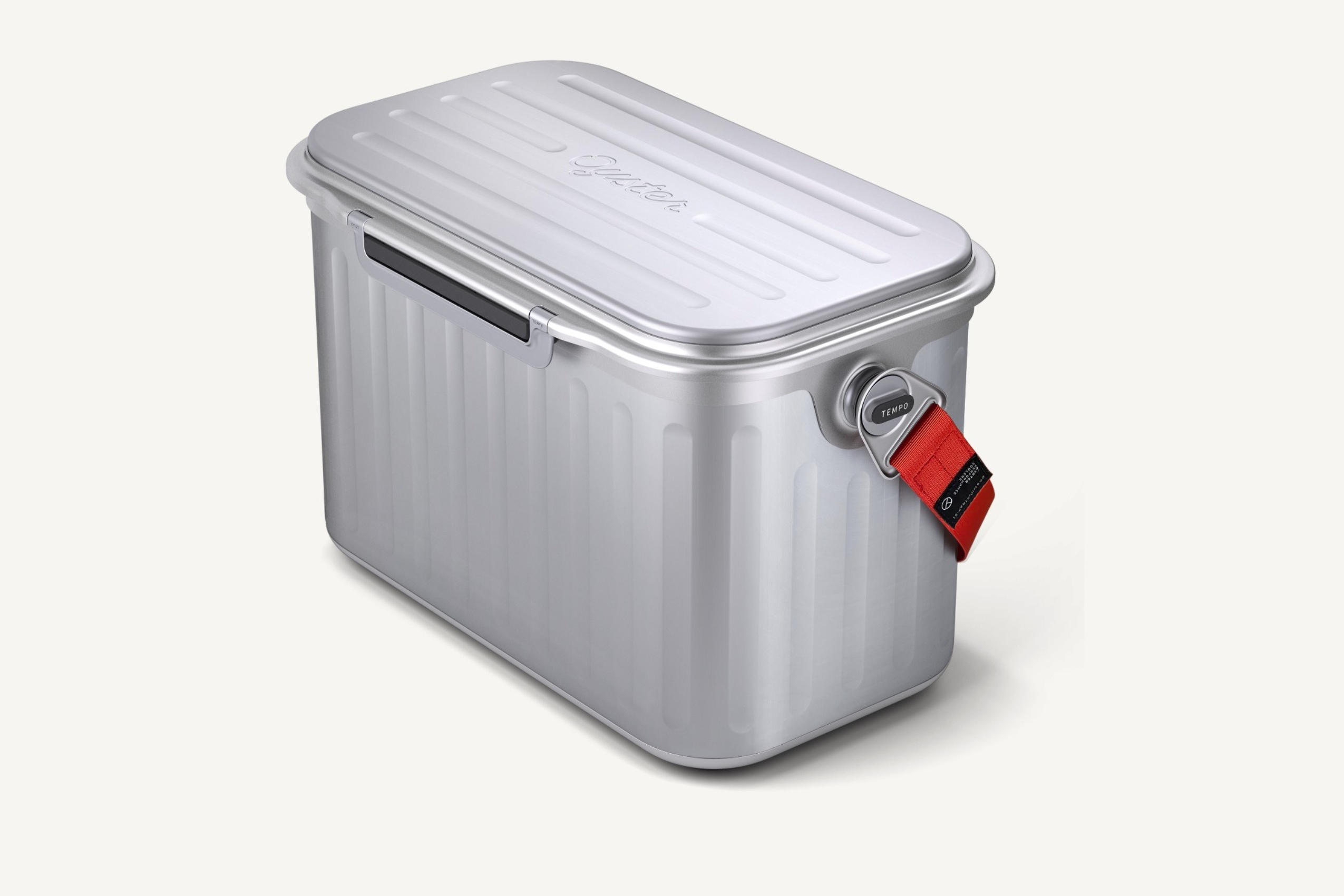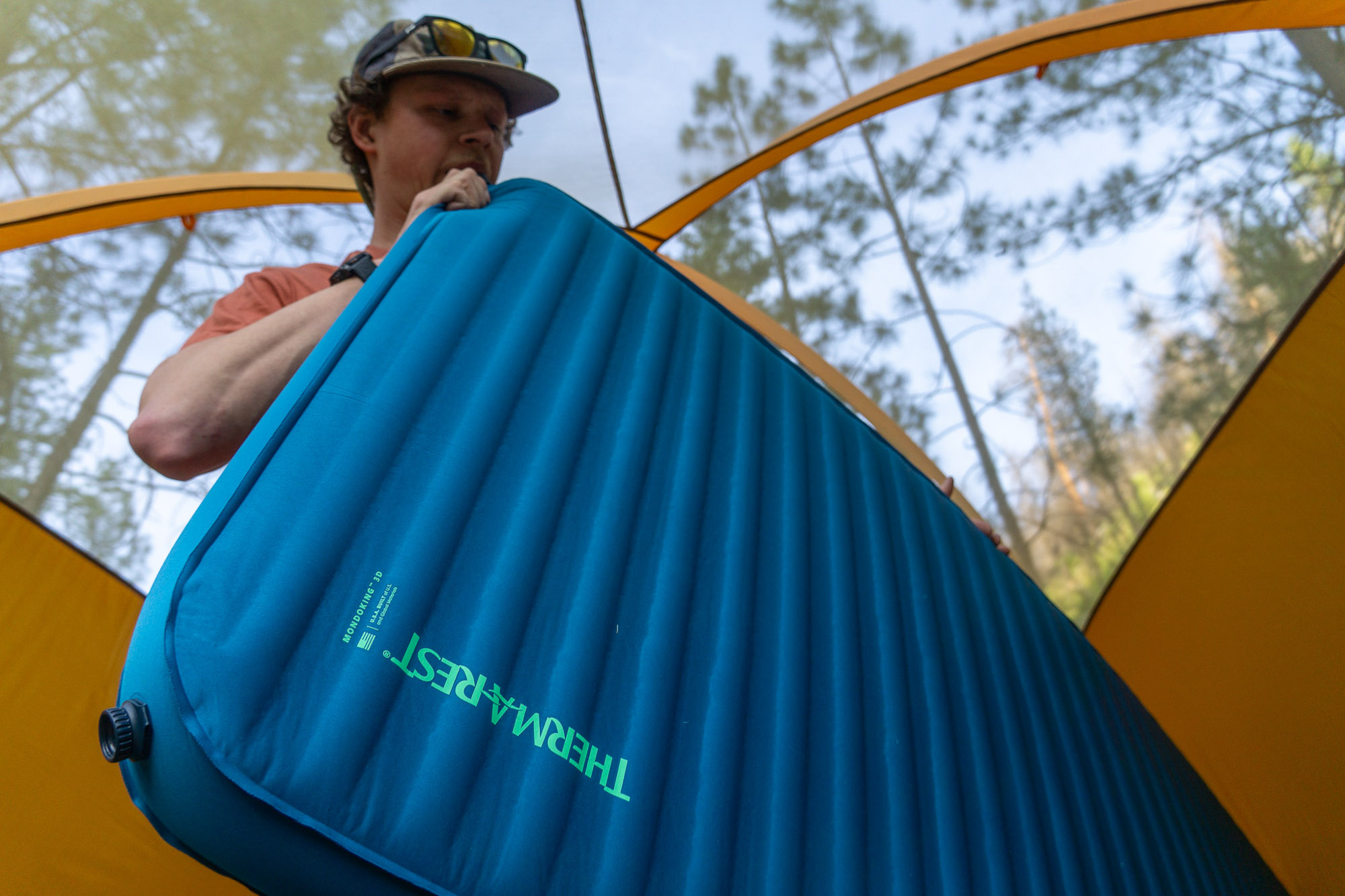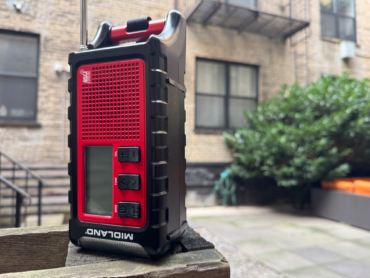The Oyster Tempo aluminum cooler was going to be baking in the car for at least a few hours. I hadn’t remembered it until we were about 3 miles into an 8-mile bike ride. I’d left the thing in the passenger seat full of veggies, leftovers, and two steaks — with no ice to keep it cold.
Instead of ice, I inserted two tablet-sized cold thermal ice packs Oyster provided, and that was it. It seemed a worthy test of the brand’s big claim: Those cooler blocks were all that was necessary to keep the Tempo’s contents cool. According to the brand, its “performance cooler” is so efficient at trapping temperature and circulating it around its interior, the Tempo doesn’t need ice cubes to stay cold — only cold thermal ice packs.
But I hadn’t planned on leaving the cooler to roast inside the car. I felt a tinge of anxiety about our steaks spoiling, but didn’t have much of a choice at that point.
Unlike roto-molded polyurethane (PU) coolers, the double walls of the Oyster Tempo are vacuum-sealed like a thermos. It traps cold (or heat), which then spreads evenly around the cooler’s interior by its aluminum tub — purportedly eliminating the need for ice.
But could that possibly hold true for a cooler roasting at 90+ degrees inside a hot car? Read on for the full report on how our ice-less steaks fared.
In short: I tested the Oyster Tempo aluminum cooler over 3 months, weekend after weekend, on camping trips, road trips, and quick trips to barbeques at friends’ houses. I even side-by-side tested it in a temperature-controlled environment with a YETI cooler of roughly the same interior size. It has performed well — and for $500 (!) it absolutely should. It isn’t without drawbacks and opportunities for improvement. Its claim of “no ice necessary,” though technically true, is a slight overstatement, as it does need cold thermal ice packs to maintain its chill. Still, Oyster comes out of the gate strong with its very first product, the Tempo.
- External dimensions: W 19.4”, H 12.6”, D 11.6” (without handle)
- Internal dimensions: 24.3 qts. / 5 gals. / 36 beverage cans
- Weight: 12.3 lbs.
- First-edition MSRP: $605
Pros
- Maintains low temps with just freezer packs
- Lots of user-friendly features make it easy to use
- Less bulky than other premium coolers of similar size
- Great warranty
Cons
- No drain plug
- Aluminum handle prone to failure
- Expensive
Oyster Tempo Aluminum Cooler: Review
Oyster launched the Tempo in April this year. GearJunkie covered the brand’s debut and interviewed the Oyster chief design officer and co-founder, Ian Sandmæl, about its unique claim that this cooler is “ice-free.”
He explained how the design uses a patented double-wall vacuum insulation technology that is very similar to the technology thermoses have been using since 1892. That creates a nearly impenetrable temperature barrier, trapping cold and holding out heat (or vice versa).
Roto-molded PU plastic coolers, by comparison, use PU foam insulation to create a temperature barrier. It works. But it’s not as unyielding as a vacuum seal. According to Oyster, its coolers stay three times cooler than ordinary premium coolers; its coolers’ core insulation is twice as good; and the thermal bridge (where heat can sneak through the gaps in the lid) is sealed 1.4 times better.
Those are some bold claims. So I put them to the test.
Battle of the Coolers: YETI 35 vs. Oyster Tempo

I have a YETI 35 and figured it would be an almost perfect competitor for comparison. It’s a 28-quart premium cooler and the Oyster is a 24.5-quart cooler. So, they’re pretty close in size. The interior volume is just slightly different, though, so take this experiment with a grain of salt. It’s as close as I could get.
The Oyster comes with two “thermal batteries” or cooling packs. They weigh 30 ounces each and are approximately 8 inches by 8 inches square. You can buy these on the Oyster website. The Tempo cooler comes with two of them. YETI sells a similar “no ice” cold thermal ice pack on its website that comes in different sizes.
For the test, I placed the two Oyster cold thermal ice packs inside the aluminum cooler and let them sit for 12 full hours. At the beginning of the experiment, the cooler was 70 degrees (or room temperature in my kitchen). At 12 hours, it had cooled down to 32 degrees inside.
I repeated the experiment, but the second time, I placed a room-temperature six-pack inside. By the 12-hour mark, it was hovering around 38 degrees and the beers felt cold.
I repeated the exact same experiment with the YETI 35. At 12 hours with just the Oyster cold thermal ice packs, it was maintaining a temp of 41 degrees. With the room temperature six-pack added, at 12 hours the YETI was maintaining 46 degrees inside.
An 8- to 9-degree difference is nothing to scoff at. But again, the interior volume of these two coolers is not exactly the same, which could account for the differences in performance. However, it was clear that the Oyster Tempo performs at least similarly to the YETI 35 — possibly even better.
Smaller on the Outside

One of the compelling aspects of the Oyster Tempo’s vacuum-sealed walls is their size. Looking at the YETI 35 and the Oyster Tempo side-by-side, you’d never guess that they held within 4 quarts of the same volume. The Yeti looks so much bigger on the outside.
But that’s one of the big drawbacks of roto-molded PU coolers that use foam for insulation. Their walls are thick, which makes them that much bulkier.

The Oyster Tempo looks like a lunch box when you set it next to the YETI. But on the inside, the Oyster Tempo holds 36 canned beverages. The YETI 35 can hold up to 39.
I noticed that difference in size almost immediately when I packed the car for camping trips. I normally reserve a pretty significant chunk of space in my truck bed for the YETI (21.1″ W x 15.9″ D x 15.4″ H). But the Oyster (19.4” W x 11.6” D x 12.6” H) took up far less space.
User-Friendly Features

Oyster didn’t hold back on extra features for this cooler, either. The Tempo comes with two different carrying options: an aluminum handle and a nylon strap. They both attach via clips that easily snap into the sides. I much prefer the strap (and I’ll tell you why in a minute).
The Oyster Tempo lid is also fully removable and can be opened from either side. It’s a unique design that allows people to easily access the contents without getting out of their beach chairs or spinning the cooler 180 degrees.
It also makes cleaning the Oyster Tempo much easier, since you can simply remove the lid and hose it out in a kitchen sink. And, being fully aluminum, the Oyster is also 100% recyclable.
Oyster Cooler: Cons

The Tempo’s first drawback jumped out at me almost as soon as I pulled it out of the box: there is no drain plug. For a cooler that markets itself with the tagline “no ice necessary,” maybe that makes sense.
But realistically, people will still put ice into it. I certainly did. The cold thermal ice packs eventually warm up — and some of us will forget to toss them in the freezer between uses.
And when that ice inevitably starts melting and pooling at the bottom, the only way to drain it is to empty the cooler and dump it out — or turn it sideways with all the contents still inside and let the water drain.
I’m sure part of the reasoning for leaving that feature out has to do with maintaining the vacuum seal’s integrity throughout the Oyster Tempo’s walls. Not only would a drain plug create one more point for the temperature to leak through, but it might be very difficult to mold the aluminum walls in such a way as to accommodate a drain plug without compromising the vacuum seal.
I get why Oyster avoided the drain plug on the Tempo. But hopefully, future iterations or models will devise a way to include one.
The second drawback had to do with the aluminum handle (mentioned above, pictured below). It worked for several camping trips without issue. But one day when I was unloading the car at home — with the cooler full to its brim with beer, food, and ice packs — the handle bent and broke off. I literally just picked it up and the thing buckled in my hand.
Luckily I had the strap to alternate in. And it’s worked wonderfully for me since. (Oyster also sent a video after this review was written, with a tutorial about how to properly lock the handle in place onto the cooler. So this might have been a user error.)

I also have to point out that this cooler is not bear-resistant. Unlike YETI, ROVR, and RTIC, the Oyster Tempo will not keep a bear from getting into it.
But that’s okay. Oyster factored this into its warranty. The website states, “Aluminum is ideal for keeping beers cold, but less so at fighting bears. Which is why we have a return policy that’s almost as cool as our technology. If a part breaks, we replace it. If a Tempo gets mauled by a bear, return it and we’ll melt its remains and make a new one.”
Finally, the price: Spending $500 on a cooler of any kind is a big ask. I’ve never spent that much on a cooler. The YETI 35 I own cost me $275, and I thought that was outrageous when I bought it.
But there is a lot of cool tech that’s gone into designing the Oyster Tempo. And YETI’s own aluminum “vacuum sealed” cooler costs a whopping $800 (and isn’t technically fully vacuum sealed like the Oyster). So, even if the price seems high, it’s on par for the course.
Oyster Tempo Cooler: The Final Word

You can tell that Oyster didn’t just slap this Tempo cooler together and rush to market. Clearly, the designers put a lot of thought into how to make the most efficient product possible — the world’s first performance cooler — one that needs no ice. Oyster used a technology that’s been around for 100-plus years and managed to create a relatively novel product to launch its brand.
So, did the Oyster measure up? As luck would have it, when we finally returned to the car from my sweltering bike ride, I discovered that my fears were unwarranted. The cooler’s exterior was hot to the touch, but its contents were still nice and cool. Our steaks were fine.
I only used the Tempo without ice a few times, if I’m being honest. Enough times to prove that, yes, it’s possible to keep food fresh and cool in the Oyster Tempo without ice, even in a hot car for several hours. But I wasn’t going to play that game every time.
So now, just like I would with any other cooler, I throw half a bag of ice into the bottom with the beers, to make sure the Tempo is as cold as possible. And it works wonderfully. When you actually use ice in the Tempo, it maintains glacially low temperatures. It’s a cool marketing fact that it doesn’t need ice — but why wouldn’t you use some anyway?
Overall, I’ve been impressed with the Oyster Tempo Cooler. That’s especially considering that this is the brand’s first product. Where it goes from here remains to be seen. But Oyster has started off on very solid footing with a very solid product. Even if the Tempo does cost an arm and a leg.









